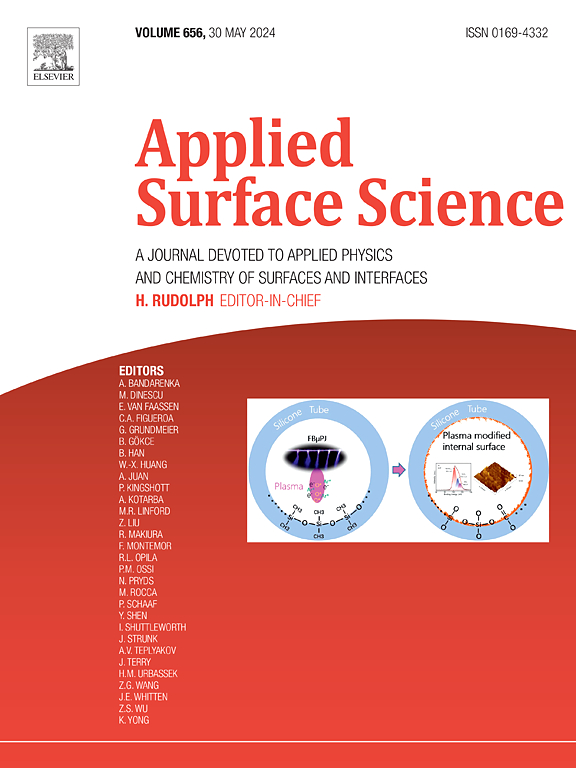Constructing aramid nanofibers self-assembly structure on fiber surface with electric field-assisted enhances insulation performance of aramid fiber reinforced epoxy resin
IF 6.3
2区 材料科学
Q2 CHEMISTRY, PHYSICAL
引用次数: 0
Abstract
Aramid fiber reinforced epoxy resin composites (AFEP) exhibit excellent mechanical strength and insulation properties, making them key materials for insulation pull rods in Gas-Insulated Switchgear (GIS). The unique long-chain benzene ring structure in aramid fiber molecules ensures high performance but also reduces surface roughness and chemical reactivity, hindering the formation of stable interfacial structures with polymers like epoxy. This study proposes using an electric field-assisted method to construct the aramid nanofiber (ANFs) self-assembly structure on the aramid fiber surface, increasing roughness and chemical reactivity, thereby enhancing the interfacial bonding strength and insulation properties of AFEP. Testing revealed that the ANFs self-assembly structure was successfully formed on the aramid fiber surface, leading to improvements in both the electrical and mechanical properties of AFEP. The performance of AFEP material was optimal when the electric field-assisted treatment was carried out for 3 min. The flashover voltage was increased by 36.75 %, and the breakdown field strength was increased by 69.08 %. The tensile strength and shear strength were increased by 17.79 % and 30.92 %, respectively. Through molecular simulation, the results show that the addition of ANFs can enhance the interface bonding strength of the model by about 35.5 %. The diffusion coefficient of the epoxy resin was reduced by 68.1 %, indicating that the interface properties of the modified composite were greatly improved. This modification method provides a new idea for non-destructive enhancement of the comprehensive properties of aramid fiber epoxy resin materials.


电场辅助在纤维表面构建芳纶纳米纤维自组装结构,提高了芳纶纤维增强环氧树脂的绝缘性能
芳纶纤维增强环氧树脂复合材料(AFEP)具有优异的机械强度和绝缘性能,是气体绝缘开关设备(GIS)中绝缘拉杆的关键材料。芳纶纤维分子中独特的长链苯环结构确保了高性能,但也降低了表面粗糙度和化学反应性,阻碍了与环氧树脂等聚合物形成稳定的界面结构。本研究提出采用电场辅助的方法在芳纶纤维表面构建芳纶纳米纤维(ANFs)自组装结构,提高其粗糙度和化学反应性,从而提高AFEP的界面结合强度和绝缘性能。测试表明,在芳纶纤维表面成功形成了ANFs自组装结构,从而提高了AFEP的电学和力学性能。电场辅助处理时间为3 min时,AFEP材料的性能最佳。闪络电压提高36.75 %,击穿场强提高69.08 %。抗拉强度和抗剪强度分别提高17.79 %和30.92 %。通过分子模拟,结果表明,ANFs的加入可使模型的界面结合强度提高约35.5% %。环氧树脂的扩散系数降低了68.1 %,表明改性复合材料的界面性能得到了很大的改善。这种改性方法为无损提高芳纶纤维环氧树脂材料的综合性能提供了新的思路。
本文章由计算机程序翻译,如有差异,请以英文原文为准。
求助全文
约1分钟内获得全文
求助全文
来源期刊

Applied Surface Science
工程技术-材料科学:膜
CiteScore
12.50
自引率
7.50%
发文量
3393
审稿时长
67 days
期刊介绍:
Applied Surface Science covers topics contributing to a better understanding of surfaces, interfaces, nanostructures and their applications. The journal is concerned with scientific research on the atomic and molecular level of material properties determined with specific surface analytical techniques and/or computational methods, as well as the processing of such structures.
 求助内容:
求助内容: 应助结果提醒方式:
应助结果提醒方式:


